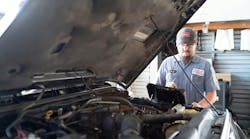One of the most overlooked and underappreciated aspects of a shop environment is the safe practice of correctly lifting and supporting vehicles while maintenance is being completed. In my experience, often, when a technician starts a job in a shop, their training includes how to complete a work order, how to answer the phone and how to do a million other things, Rarely, however, does it include formal training on how to properly lift and support a vehicle. Many shop managers assume this knowledge already exists with each technician. This can be a very dangerous and costly assumption.
Safe lifting techniques can be easily taught and practiced throughout the shop. These techniques are not only for lifting all or part of a vehicle, but for lifting and supporting vehicle components. Today, our focus will be on safely and correctly lifting and supporting a heavy duty vehicle using a Gray FSJ-120 floor jack and properly rated Gray 10-TF vehicle support stands.
The most important thing to understand about using any floor jack is the jack itself is a lifting device only. While raising the truck with the jack, an operator should keep his or her body out from under the vehicle. After the vehicle is raised to the desired height, it is not safe to go under the vehicle for any reason until adequate vehicle support stands have been properly placed and the vehicle safely lowered onto the support stands. While placing the support stands (stands must contact a safe lifting point on the vehicle, as recommended by the OEM), the technician should place the stands in such a way they can minimize the amount of his or her body that is under the vehicle.
The selection of properly sized support stands is important to safely support the lifted vehicle. First, it is important to note on the selected stands if the stated capacity is a combined capacity or the capacity of each individual stand. The Gray 10-TF, for example, is a pair of stands with each stand being rated at a 20,000-lb capacity. A common misconception is adding both stands together and assuming, in this example, the stands have a combined capacity of 40,000 lbs. This is an incorrect assumption.
Following ASME PASE standards, vehicle support stands must be used as a matched pair and each vehicle support stand used should match or exceed the capacity of the floor jack used to raise the vehicle. So, if using the Gray FSJ-120, a 12,000-lb capacity floor jack, a technician should use vehicle support stands with a minimum rated capacity of 12,000 lbs per stand (not combined capacity). When each stand is rated at a 12,000-lb capacity, there is no question when the vehicle is lowered onto the stands if the stands will support the vehicle.
Also of note, ASME PASE standards warn against lifting a vehicle with a floor jack to put the entire vehicle on support stands. Technicians occasionally will use a floor jack to lift one end of the vehicle, support that end with support stands and repeat the process on the opposite end of the vehicle, thus supporting the entire vehicle on support stands. This is an unsafe practice that may cause the vehicle to fall from the first set of stands placed and may cause physical and property damage.
In summary, to safely lift and support a vehicle for maintenance work (always lift and support the front or back, never the side of the vehicle), follow the following steps:
- Select a floor jack that is the correct capacity and in working order.
- Place the floor jack under the end of the vehicle to be raised, making sure it is contacting a OEM approved lifting point.
- Check that the floor jack will be able to roll forward freely. Remove any obstructions and check that the floor is smooth, level and even.
- Using the floor jack, lift the vehicle to the desired height, while keeping the operator’s body out from underneath the vehicle.
- Place properly matched vehicle support stands (capacity of each stand should meet or exceed the jack used to lift the vehicle) under the vehicle to contact OEM identified lifting points, while minimizing the amount of the operator’s body that is under the vehicle.
- While keeping clear of the underside of the vehicle, lower the vehicle onto the support stands and remove the floor jack to create clear access under the vehicle.
The lifting and supporting of a vehicle is potentially the most dangerous activity in today’s shop. Understanding how to safely achieve this is vitally important. Following a few simple guidelines will insure a safe shop floor.


